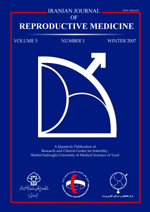
|
International Journal of Reproductive BioMedicine
Research and Clinical Center for Infertility, Shahid Sadoughi University of Medical Sciences of Yazd
ISSN: 1680-6433
EISSN: 1680-6433
Vol. 15, No. 3, 2017, pp. 147-154
|
 Bioline Code: rm17020
Bioline Code: rm17020
Full paper language: English
Document type: Research Article
Document available free of charge
|
|
|
International Journal of Reproductive BioMedicine, Vol. 15, No. 3, 2017, pp. 147-154
| en |
Association of regional disparity of obstetrics and gynecologic services with children and infants mortality rates: A cross-sectional study
Tourani, Sogand; Zarezadeh, Mohammad; Raadabadi, Mehdi & Pourshariati, Fatemeh
Abstract
Background: Equity in distribution of resources is considered as an important
priority in health care systems. Equitable distribution of obstetrics and gynecology
(Ob/Gyn) services in the country level is critical in maternal and neonatal health for
qualitative promotion of maternal care in pregnancy, delivery, and post-delivery
periods.
Objective: The present study aimed at determining regional disparity of obstetrics
and gynecology services and its association with children and infants mortality rates.
Materials and Methods: This was a descriptive-analytical study conducted in 2015
to investigate distribution of Ob/Gyn services using three indicators of number of
nursing and midwifery personnel, total Ob/Gyn specialists, and total delivery beds
among 30 provinces of the country. Equity criteria in the present study included
population, normal vaginal deliveries, cesarean sections, and total deliveries. Data
were gathered using a researcher-made form and Stata 12 was used to calculate Gini
coefficient. The association of Ob/Gyn services with children and infant mortality
rates was investigated using SPSS package and linear regression test.
Results: The lowest Gini coefficient was observed in distribution of nursing and
midwifery personnel in delivery wards in terms of vaginal delivery (0.38 from 1)
and the highest value was related to distribution of Ob/Gyn specialists in terms of
vaginal delivery (0.73 from 1). Infant mortality was significantly associated with
number of nursing and midwifery personnel in delivery wards, and total number of
Ob/Gyn specialists.
Conclusion: Considering new population policies in Iran and increased fertility rate,
it is recommended to facilitate accessibility of the required services for the women,
particularly those of reproductive age.
Keywords
Obstetrics and gynecologic services; Children and infants mortality; Gini; Equity; Health Care.
|
| |
© Copyright 2017 - International Journal of Reproductive Medicine
Alternative site location: http://www.ijrm.ir
|
|
